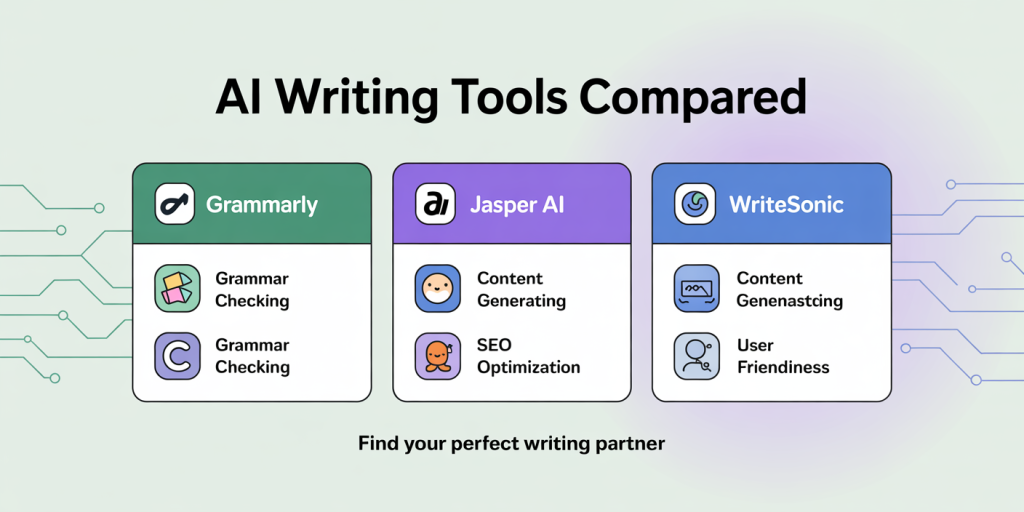Best AI Writing Tools for Non-Writers to Sound Like Pros
In today’s digital era, the demand for high-quality written content is continually growing. Whether it’s creating blog posts, social media updates, professional emails, or marketing copy, clear and compelling writing is essential. However, not everyone possesses the innate skills of a professional writer. For those non-writers aiming to produce polished, professional-grade text, AI writing tools have emerged as invaluable assistants. These tools leverage artificial intelligence to enhance, streamline, and even generate written content, transforming novices into capable scribes almost instantaneously.
AI writing tools have gained significant traction with a surge in adoption across industries, fueled by advancements in natural language processing (NLP) and machine learning. According to a 2023 report by Market Research Future, the global AI writing assistant market is expected to grow at a compound annual growth rate (CAGR) of 26.3% between 2022 and 2030. This rapid growth highlights the increasing role of AI in democratizing writing skills, enabling non-experts to communicate with clarity, fluency, and persuasion. Below, we explore some of the best AI writing tools designed specifically to elevate the writing of those who lack formal training, backed by data, practical examples, and comparative insights.
How AI Writing Tools Empower Non-Writers
Non-writers often face difficulties structuring thoughts, grammar mistakes, limited vocabulary, and inconsistent tone, which can compromise the quality of their written communication. AI writing tools bridge this gap by offering features like grammar correction, style enhancement, content suggestions, and tone adjustments — essentially functioning as real-time writing coaches.

A diverse group of non-writers happily using AI writing tools on laptops and mobile devices, with visual elements showing grammar correction, tone adjustment, and content suggestions on their screens.
Anúncios
For example, a small business owner with limited writing experience can craft professional marketing emails by simply inputting key ideas into an AI tool, which then refines the message into engaging and persuasive copy. In another case, a non-native English speaker can use AI to produce fluent and idiomatic content, improving readability and audience engagement. Tools like Grammarly, Jasper AI, and Writesonic deploy sophisticated language models trained on vast datasets, enabling precise grammar corrections while preserving original voice and intent.
The benefits extend beyond mere correction. AI empowers users to experiment with different writing styles and tones. A single draft can be adapted for formal reports, conversational social media posts, or creative storytelling by toggling settings. This flexibility fosters creativity and confidence, making writing less intimidating and more productive for non-experts.
Top AI Writing Tools for Non-Writers: Features and Benefits
Several AI writing platforms cater to varied user needs, making it crucial to understand their functionalities and strengths. Below is a detailed overview of some of the best tools currently available:
Anúncios
| Tool Name | Primary Features | Best For | Pricing Model | User Friendliness |
|---|---|---|---|---|
| Grammarly | Grammar check, style suggestions, tone detection | Everyday writing enhancement | Freemium + Premium plans | Intuitive interface |
| Jasper AI | Content generation, marketing copy, brainstorming | Content creation professionals | Subscription-based | Moderate learning curve |
| Writesonic | AI content generation, SEO optimization, templates | Bloggers, marketers | Freemium + Paid plans | Easy to navigate |
| ProWritingAid | In-depth grammar analysis, style, readability reports | Academics, authors | One-time or subscription | Feature-rich UI |
| Copy.ai | AI-generated marketing copy, social media posts | Entrepreneurs, social media | Subscription-based | Simple and fun |
Grammarly stands out by providing real-time writing feedback, not only fixing typos and grammar errors but also suggesting vocabulary enhancements and ensuring tone appropriateness for different audiences. For instance, a customer service representative using Grammarly can avoid unintended rudeness by receiving tone alerts before sending emails.

An infographic-style comparison table illustrating features and benefits of top AI writing tools like Grammarly, Jasper AI, and Writesonic, with icons representing grammar checking, content generation, SEO optimization, and user friendliness.
On the other hand, Jasper AI excels in content creation by generating entire articles or marketing copy from brief prompts. A non-writer managing a blog could input key topics, and Jasper produces readable drafts, which the user can personalize further. According to Jasper’s 2023 user survey, 78% of users reported saving over 50% of their writing time when using the platform.
Writesonic emphasizes SEO-friendly content generation, enabling users to create blog posts optimized for search engine rankings effortlessly. This is particularly valuable for small business owners and content marketers with limited SEO knowledge. ProWritingAid offers comprehensive reports on readability and writing style, making it ideal for those who want to learn and improve their craft. Copy.ai simplifies social media content creation, allowing quick generation of catchy posts that resonate with target audiences.
Practical Applications and Real-World Examples
The utility of AI writing tools spans various domains and industries, proving their versatility and effectiveness in boosting writing confidence and quality.
A pertinent example is Sarah, a freelance graphic designer without formal writing training. She needed to maintain an engaging blog for her portfolio. Using Jasper AI, Sarah generated informative blog posts from simple bullet points, saving hours she previously spent struggling with drafts. Her website traffic increased by 40% within three months post-adoption, demonstrating improved content effectiveness.
In the corporate world, a global consulting firm implemented Grammarly Business to ensure consistent communication standards across a multilingual workforce. This resulted in a 30% reduction in client-related communication errors and improved professionalism in client reports and proposals.
Another case involves a small online retailer that used Writesonic to create product descriptions optimized for SEO. After integrating AI-generated descriptions, the retailer noted a 25% boost in organic search traffic and a 15% rise in sales conversions within six weeks.
These examples highlight how AI writing tools not only assist non-writers in sounding professional but also contribute to tangible business outcomes.
Comparative Analysis: Choosing the Right AI Writing Tool
Choosing an AI writing tool depends on individual needs, technical comfort, budget, and specific writing goals. The following table illustrates a comparative analysis to help identify the most suitable option for common user profiles:
| User Profile | Recommended Tool(s) | Reasons | Potential Drawbacks |
|---|---|---|---|
| Casual writers | Grammarly | Easy to use, free tier, excellent basic corrections | Limited content generation |
| Marketers & bloggers | Jasper AI, Writesonic | Strong content generation and SEO tools | Higher cost, learning curve |
| Academic writers | ProWritingAid | Advanced style reports, reference checks | Interface might be complex |
| Social media managers | Copy.ai | Quick, catchy post generation | Less suited for long formats |
| Multilingual teams | Grammarly Business | Tone detection, cross-language consistency | Premium pricing |
For example, if a user mainly seeks grammar correction and style improvement while drafting emails or casual content, Grammarly’s free plan offers substantial value without complexity. Conversely, content marketers desiring to automate blog writing and social media posts might favor Jasper AI or Writesonic for their robust AI-generated outputs geared toward engagement and SEO.
Educators and authors who require detailed stylistic feedback and suggestions would benefit from ProWritingAid’s depth. Meanwhile, Copy.ai suits users needing fast content for social platforms but isn’t recommended for longer or more formal compositions.
Enhancing Writing with AI: Best Practices
To extract maximum value from AI writing tools, non-writers should adopt certain best practices. Rather than relying entirely on AI-generated text, users should view these tools as collaborators that assist and inspire human creativity.
First, always review and personalize AI-suggested content. While AI can produce grammatically sound and coherent text, it may lack personal nuance or domain-specific knowledge. Adding individual insights, examples, and a unique voice elevates content authenticity and engagement.
Second, leverage tool features aligned with goals. For instance, if tone correctness is vital (e.g., customer emails), enable tone detection features. Content creators focused on SEO must utilize keyword suggestions and optimization tips that tools like Writesonic provide. Non-native English speakers might use vocabulary enhancement tools in Grammarly to diversify expression and idiomatic usage.
Third, maintain a feedback loop. Use insights from AI to learn and improve one’s writing skills. Tools like ProWritingAid provide detailed reports identifying recurring errors or style inconsistencies, which users can consciously work on over time.
Finally, ensure data privacy and ethical considerations. Most AI writing providers follow stringent data policies, but avoid submitting sensitive or confidential information without verifying tool security and compliance with regulations such as GDPR.
Looking Ahead: The Future of AI Writing for Non-Writers
The future of AI writing tools promises even more sophisticated capabilities, enabling non-writers to produce high-caliber content with minimal effort. Advances in AI models, such as GPT-4 and beyond, allow for more context-aware, creative, and personalized writing assistance.

A futuristic workspace scene depicting a writer collaborating seamlessly with an AI assistant, showcasing real-time text improvements, multilingual support, and creative writing enhancements on a large transparent screen.
Improvements in multilingual NLP will broaden access, helping users alike to craft content in various languages without needing native proficiency. Real-time collaboration features integrated into writing tools will facilitate seamless teamwork between AI and human authors, fostering co-creation.
Furthermore, increased integration with other platforms — content management systems, email clients, and social media management tools — will streamline workflows, allowing users to generate, edit, and publish content in fewer steps. AI tools will also become more adaptive, learning individual writing preferences and stylistic nuances, thus producing suggestions more aligned with personal voice and brand personality.
Ethical AI use and transparency will remain key discussion points. Developers are focusing on reducing biases and ensuring AI-generated content respects copyright and intellectual property rules. As AI writing becomes mainstream, continuous improvements in usability, affordability, and trust will democratize access, enabling more non-writers to communicate like pros effectively.
In summary, AI writing tools have transformed the landscape for non-writers seeking professional-quality text. By combining robust grammar and style correction with intelligent content generation and SEO capabilities, these tools reduce barriers, boost productivity, and enhance the clarity and persuasiveness of written communication. Selecting the right AI tool based on individual needs and following best practices can unlock the full potential of AI assistance today, while ongoing innovation promises an even more empowering future for users at all skill levels.
